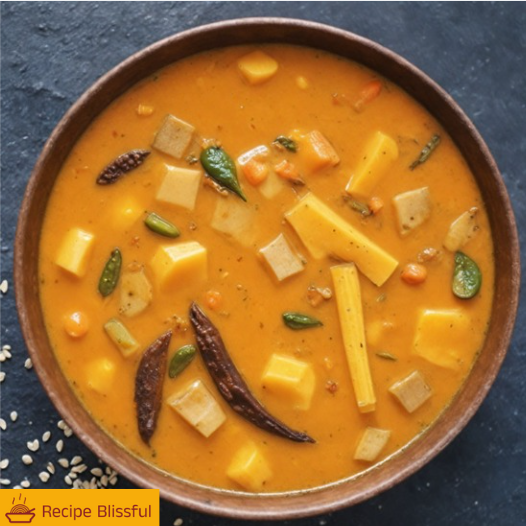
Introduction:
Sambar Recipe
Sambar is a quintessential South Indian dish, perfect for those who love a tangy, spicy, and hearty stew made with lentils, vegetables, and a unique blend of spices. It’s often served as a side dish with idli, dosa, or rice but is delicious enough to enjoy on its own. Sambar is the soul food of every South Indian household, and here’s my take on a simple, yet flavour-packed sambar recipe that you can make at home.
TOC Quickly Jump to:
- Jump to the recipe
- ingredients
- (serving size Prep time cook time total time)
- Serving Suggestions
- Cooking Tips
- Conclusion
- FAQs
Ingredients:
For the Dal:
- Toor Dal (Split Pigeon Peas): 1/2 cup
- Water: 2 cups
- Turmeric Powder: 1/4 tsp
For the Vegetables:
- Drumstick (Moringa): 1, cut into pieces
- Carrot: 1, chopped
- Brinjal (Eggplant): 1, cubed
- Tomato: 1, chopped
- Shallots: 10-12, peeled
- Tamarind Pulp: 2 tbsp (soak a lemon-sized ball of tamarind in warm water for 10 minutes and extract the juice)
For Sambar Masala:
- Sambar Powder: 2 tbsp (you can use store-bought or homemade)
- Coriander Powder: 1/2 tsp
- Red Chili Powder: 1/2 tsp (optional for extra heat)
- Asafoetida (Hing): 1/4 tsp
For Tempering:
- Mustard Seeds: 1 tsp
- Cumin Seeds: 1/2 tsp
- Dry Red Chilies: 2
- Curry Leaves: 10-12
- Fenugreek Seeds: 1/4 tsp
- Oil/Ghee: 2 tbsp
- Fresh Coriander Leaves: A handful, finely chopped for garnish
Serving Size:
- Serves: 4
Prep Time:
- Prep Time: 15 minutes
Cook Time:
- Cook Time: 30 minutes
Total Time:
- Total Time: 45 minutes
Step-by-Step Instructions:
Step 1: Cook the Dal
Start by rinsing the toor dal thoroughly. Pressure cook the dal with 2 cups of water, turmeric powder, and a pinch of salt. Let it cook for 3-4 whistles until soft and mushy. Once done, mash the dal well and set it aside.
Step 2: Cook the Vegetables
In a separate pot, add chopped drumstick, carrots, brinjal, shallots, and tomato. Add enough water to cover the vegetables and bring it to a boil. Cook the vegetables until tender, which should take about 10 minutes.
Step 3: Add Tamarind and Masala
Once the vegetables are soft, add the tamarind pulp, sambar powder, coriander powder, red chili powder, and asafoetida. Stir everything together and allow the sambar to simmer for 5 minutes to absorb the flavors of the spices and tamarind.
Step 4: Mix in the Dal
Now, add the mashed dal to the vegetable mixture. Adjust the consistency by adding water as needed. Let the sambar simmer on low heat for 10 minutes, allowing the flavors to meld beautifully.
Step 5: Tempering the Sambar
In a small pan, heat oil or ghee on medium heat. Add mustard seeds and allow them to splutter. Then, add cumin seeds, dry red chilies, curry leaves, and fenugreek seeds. Fry for a minute until aromatic. Pour this tempering over the simmering sambar and stir well.
Step 6: Final Touches
Turn off the heat and garnish the sambar with freshly chopped coriander leaves. Give it a good stir and let it rest for a couple of minutes before serving.
Serving Suggestions:
Sambar is traditionally served with steamed rice, idli, dosa, vada, or even as a side dish for pongal. For a complete South Indian meal, serve it with a dollop of ghee and papad on the side.
try now The Perfect Sugar Cookie Recipe: Sweet and Simple Treats
Cooking Tips:
- Tamarind to Taste: The tanginess of sambar comes from tamarind. Adjust the quantity based on your preference. Some like it more tangy, while others prefer it mild.
- Add Vegetables of Choice: You can customize your sambar with vegetables like pumpkin, potatoes, radish, or beans. The more veggies, the better!
- Consistency Matters: Sambar should have a pourable consistency. If it’s too thick, add water to adjust it while cooking.
- Homemade Sambar Powder: For a richer taste, try making your own sambar powder by dry roasting spices like coriander seeds, dried red chilies, fenugreek, cumin, and grinding them into a fine powder.
Conclusion:
Sambar is more than just a dish; it’s an experience that brings warmth, comfort, and a burst of flavors in every bite. Whether it’s a humble breakfast or a grand festive meal, sambar finds its place in every South Indian kitchen. With this easy recipe, you’ll be making an authentic bowl of sambar that’s sure to impress your taste buds!
FAQs
- Can I store sambar?
Yes, sambar can be stored in the fridge for up to 3 days. Reheat it before serving, and it tastes even better the next day. - Can I make sambar without toor dal?
You can substitute toor dal with moong dal or masoor dal, but toor dal is traditionally used for its rich, creamy texture. - Is sambar spicy?
Sambar has a moderate level of spice, but you can adjust the heat by increasing or decreasing the sambar powder and red chili powder. - What can I substitute for tamarind?
If you don’t have tamarind, you can use lemon juice or tomato puree for tanginess, though it will alter the taste slightly. - Can I freeze sambar?
Yes, sambar freezes well. Store it in an airtight container, and it will last for about a month in the freezer. Thaw and reheat before serving.

